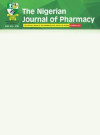Drug Labels And Advertisements: Extent Of Use As Sources Of Drug Information By Healthcare Professionals In Lagos, Nigeria
Keywords:
Drug Labels, Advertisement, Drug information, healthcare providers, NigeriaAbstract
Drug labels and advertisement are essential tools through which useful information that influence choice and provide instruction on safe and effective use of drug products are conveyed to healthcare professionals and patients. The aim of this study was to evaluate the
extent of use of labels and advertisement as sources of drug information by healthcare providers in Lagos, Nigeria. In a cross sectional
survey of healthcare providers, a Likert-type questionnaire was used to evaluate the respondent's sources of drug information and their extent of use. Summary scores ≥ 3.0 (mid-point) on the Likert scale for each identified source of drug information shows a greater extent of use compared to lower scores. Inferential analysis was done by calculation of student t-test and one-way ANOVA as appropriate. P-values less than 0.05 were interpreted as significant. The internet (3.91), professional colleagues (3.96) and Emdex (3.89) were found to be the most frequently used sources of drug information. Usage of literature inserts/drug labels (3.28), advertisement medium such as product launch (3.59) and medical journals (3.53) were found to be above the mid-point in terms of usage. Males are more likely to use physician desk reference (P=0.0082) and Professionals with years of experience less than five are most likely to rely on labels and drug advertisement (p=0.0006).However, Doctors and pharmacists appear to significantly use the internet as a source of drug information than Nurses (P=0.0018).Healthcare professionals use Commercial and non-commercial sources of drug information; the extent of use of drug labels and adverts is above average hence adequate government policy and regulation should be implemented to ensure they have appropriate, relevant, and up to date information to assist healthcare professionals take informed and cost effective patient care decisions.
References
National Agency for Food and Drug Administration and Control Decree 1993 No.15; Drug Products Labelling Regulations. Sect. 15 (2005).
Lal R, Kremzner M. (2007). Introduction to the New Prescription Drug Labeling by the Food and Drug Administration. American Journal of
Health System Pharmacy.64(23):2488-2494.
Khakhkhar T, Mehta M, Shah R, Sharma D. (2013). Evaluation of drug promotional literatures using WHO guidelines. Journal of Pharmaceutical Negative Results.4(1):33-38.
Parli K, Reema R, Devang R, Supriya M. (2016). EVALUATION OF PROMOTIONAL DRUG LITERATURE PROVIDED BY MEDICAL REPRESENTATIVE AT A TERTIARY CARE HOSPITAL. INTERNATIONAL JOURNAL OF PHARMACEUTICAL SCIENCES AND RESEARCH.8(4):1744.
International Federation of Pharmaceutical Manufacturers & Associations. (2017). The Pharmaceutical Industry and Global Health: Facts and Figures. International Federation of Pharmaceutical Manufacturers & Associations.
Grol R, Grimshaw J. (2003). From best evidence to best practice: effective implementation of change in patients' care. Lancet. 362 (9391): 1225-30. Epub 2003/10/22.
Institute of Medicine. (2007). Preventing Medication Errors. Aspden P, Wolcott J, Bootman JL, Cronenwett LR, editors. Washington, DC: The National Academies Press; 480 p.
Ray WA, Stein CM. (2006). Reform of Drug Regulation — Beyond an Independent Drug-Safety Board. New England Journal of Medicine.354(2):194-201.
Lasser KE, Seger DL, Yu DT, Karson AS, Fiskio JM, Seger AC, et al. (2006). Adherence to black box warnings for prescription medications in outpatients. Archives of internal medicine.166(3):338-44. Epub 2006/02/16.
Norris P, Herxheimer A, Lexchin J, Mansfield P. (2004). Drug promotion: what we know, what we have yet to learn (reviews of materials in the WHO/HAI database on drug promotion). In: International WHOHA, editor. Europe: World Health Organization/ Health Action International; p. 231 - 240.
Ventola CL. (2011). Direct-to-Consumer Pharmaceutical Advertising: Therapeutic or Toxic? P T.36(10):669-84. Epub 2012/02/22.
Spurling GK, Mansfield PR, Montgomery BD, Lexchin J, Doust J, Othman N, et al. (2010). Information from Pharmaceutical Companies and
the Quality, Quantity, and Cost of Physicians' Prescribing: A Systematic Review. PLoS Med.7(10):e1000352.
Weissman JS, Blumenthal D, Silk AJ, Zapert K, Newman M, Leitman R. (2003). Consumers' reports on the health effects of direct-to-consumer drug advertising. Health Aff (Millwood).Suppl Web Exclusives:W3-82-95. Epub 2003/10/07.
Raosoft Inc. (2004). Raosoft Sample Size Calculator. Raosoft Inc,; cited 2017]; Sample size calculator ] . Available from: http://www.raosoft.com/samplesize.html.
Case DO. (2012). Looking for Information: A Survey of Research on Information Seeking, Needs and Behavior: Emerald.
Effie S. (2016). Health information sources: trust and satisfaction. International Journal of Healthcare.2(1):38 - 43.
Anyanwu EU, Oparaku DC, Oyemike VB. (2016). Meeting The Information Needs Of Nurses For Effective Healthcare Delivery In Nigeria: A Case Study Of Federal Medical Centre, Owerri, Imo State. Library Philosophy and Practice (eJournal):1427.
Udezi WA, Oparah AC, Enyi KU. (2007). An Investigation of Drug Information Needs of Nigerian Pharmacists. Drug Information Journal.41(4):471-479.
Oshikoya KA, Senbanjo IO, Soipe A. (2009). Adequacy of pharmacological information provided in pharmaceutical drug advertisements in African medical journals. Pharmacy Practice.7(2):100-107.
Graf WD, Miller G, Nagel SK. (2014). Addressing the problem of ADHD medication as neuroenhancements. Expert Rev Neurother. 14(5): 569-81. Epub 2014/04/18.
S. Gopalakrishnan, Murali R. (2002). India: Campaign to tackle unethical promotion. Essential Drug Monitor(31).
Donohue J. (2006). A History of Drug Advertising: The Evolving Roles of Consumers and Consumer Protection. Milbank Q.84(4):659-699.
Malik M, Hussain A, Amin T, Hashmi A. (2016). Role of Drug Labeling in Promoting Rational Dispensing: A Literature Review. IOSR Journal of Dental and Medical Sciences.15(12):74 - 78.
Rohra DK, Gilani AH, Memon IK, Perven G, Khan MT, Zafar H, et al. (2006). Critical evaluation of the claims made by pharmaceutical companies in drug promotional material in Pakistan. J Pharm Pharm Sci.9(1):50-9. Epub 2006/07/20.

Downloads
Views | PDF Downloads:
289
/ 214


